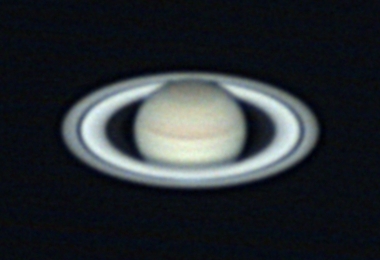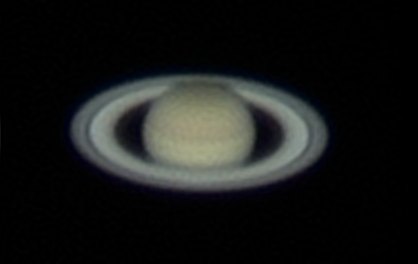y¯ f¯¤ï Ö¼x iÅVj
ALPO-Japan Latest
Saturn Image 2002/12/29(UT)
i·pv,äñ,
Ed Grafton
H.Einaga,K.Nakai,E.Grafton
|
Hideo Einaga (250mm Newton, Digital Still Camera NEC PICONA)
|
|

2002/12/29 13:29:00 (UT)
CMI = 245.0, CMIII = 154.0
De = -29.3, E.Dia = 20.49"
11 frames composite
Seeing=6/10,Trans=3/5
25cm+barlow3x+Picona(1/7s)
HIDEO EINAGA áºÉEÁ¼@i·pvâ
|
Kenji Nakai( LX200-25(254mmF10SC) , Nikon Cool Pix995)
|
|

saturn 2002/12/29 14:52:23(UT)
CM1=293.6 CM3=200.7 B=-26.65 B'=-26.70
LX200-25 (254mm Schmidt Cassegrain f/10)
LV10mm+pentaprism+Nikon Cool Pix 995(fl:13.9mm,ISO400)
f/16.7 exp.:1/4 , 1/8sec. 16frames coposite
seeing:5-6/10 transp.:2-3/5
_ªÊßµÄBeÉèÔæÁ½B
SPRªÂÎFB
áLs äñâ
|
Ed Grafton (14 inch f/11 Celestron SCT, ST6 CCD medium resolution mode)
|
|
Hi Saturn Observers
Another in a series of Saturn Storms was seen on December 29th 2002. This
storm is smaller than the previously observed storm on December 22nd at L3~
330. It is located at aprox. the same latitude as the other storms, at about
-42 degrees.
Earlier in this years Saturn apparition, there was some conjecture that
these small spots/storms have been prevalent all along and that higher
resolution images have made them visible this apparition. I do not believe
this to be true any longer. There was pretty good coverage at high
resolution by atleast three amateurs last year; myself, D. Peach and D.
Parker. None of the now seemingly ubiquitous spots were observed during the
last apparition. One must conclude that these events are a new phenomenon
over recent years.
The Storms seem to be short lived and appear and dissipate over a period of
days or a few days or couple of weeks. It seems that if the storms were of
longer duration, then the area at -42 deg would be a ring of storms at this
time. Damian Peach made an observation of the relativly bright December 22nd
L3~330 storm on December 24th and noted that it had already faded somewhat.
Given the short duration of the storms it seems most likely that the storms
are eruptive in nature and do not represent an organization of matter such
as eddies or vortexes which would have an angular momentum that would tend
to sustain them for longer periods. The short duration lends it self to the
storms being eruptive and therefore are probably convection generated.
Saturn is currenty near perhelion as it is every 30 years. The additional
solar radiation during this period may be responsible for the increase in
convection currently seen as the atmosphere heats up. Also there must be a
"heating lag" for the Saturn atmosphere just as the hottest days for the N.
hemisphere of earth is not at the Summer Solstice but occurs a few weeks
later in July or August. This would translate into a lag on Saturn of a
couple of years. If the frequency of the storms is related to perhelion then
Saturn may be even more active in this regard in the next year or two. In
the last apparition there may have been insufficient coverage at the
required resolution to consistantly detect these convective events.
Oddly the area around -42 degrees seems to be the favorite choice for the
storms to appear. Not considering a sub-atmospheric feature then it must be
that convection storms at this latitude reaching the upper atmosphere and
becoming visble where at other latitudes the convection is somehow
disrupted. Perhaps this latitude represents a "window" where atmospheric
shearing forces or less and allow the convectios to bubble into the upper
atmosphere.
The sky was clear with fog later, the transparency was good 7/10, and seeing
was average, 5/10, with no wind and heavy dew. The weather was cool with the
temperatures in the 50s F around local midnight.
 Ed Grafton, Houston Texas, ST5C CCD and a 14 inch f/11 Celestron SCT
Barlow Projection to f/27 aprox .21 arc seconds per pixel.
Image data:
10 BLUE + IR rejection, .6 seconds, SBIG filter
10 GREEN + IR rejection, .6 seconds, SBIG filter
10 RED + IR rejection, .6 seconds, SBIG filter
~100 clear filter, No IR .25 seconds, SBIG filter
PS: If you would like to be removed from this email list, please let me know.
Ed Grafton
Ed Grafton
[Ed Grafton, Houston Texas]
Ed Grafton, Houston Texas, ST5C CCD and a 14 inch f/11 Celestron SCT
Barlow Projection to f/27 aprox .21 arc seconds per pixel.
Image data:
10 BLUE + IR rejection, .6 seconds, SBIG filter
10 GREEN + IR rejection, .6 seconds, SBIG filter
10 RED + IR rejection, .6 seconds, SBIG filter
~100 clear filter, No IR .25 seconds, SBIG filter
PS: If you would like to be removed from this email list, please let me know.
Ed Grafton
Ed Grafton
[Ed Grafton, Houston Texas]
 ALPO-Japan Latest
ALPO-Japan Latest

 Saturn Section
Saturn Section
 Ed Grafton, Houston Texas, ST5C CCD and a 14 inch f/11 Celestron SCT
Barlow Projection to f/27 aprox .21 arc seconds per pixel.
Image data:
10 BLUE + IR rejection, .6 seconds, SBIG filter
10 GREEN + IR rejection, .6 seconds, SBIG filter
10 RED + IR rejection, .6 seconds, SBIG filter
~100 clear filter, No IR .25 seconds, SBIG filter
PS: If you would like to be removed from this email list, please let me know.
Ed Grafton
Ed Grafton
[Ed Grafton, Houston Texas]
Ed Grafton, Houston Texas, ST5C CCD and a 14 inch f/11 Celestron SCT
Barlow Projection to f/27 aprox .21 arc seconds per pixel.
Image data:
10 BLUE + IR rejection, .6 seconds, SBIG filter
10 GREEN + IR rejection, .6 seconds, SBIG filter
10 RED + IR rejection, .6 seconds, SBIG filter
~100 clear filter, No IR .25 seconds, SBIG filter
PS: If you would like to be removed from this email list, please let me know.
Ed Grafton
Ed Grafton
[Ed Grafton, Houston Texas]

 ALPO-Japan Latest
ALPO-Japan Latest
